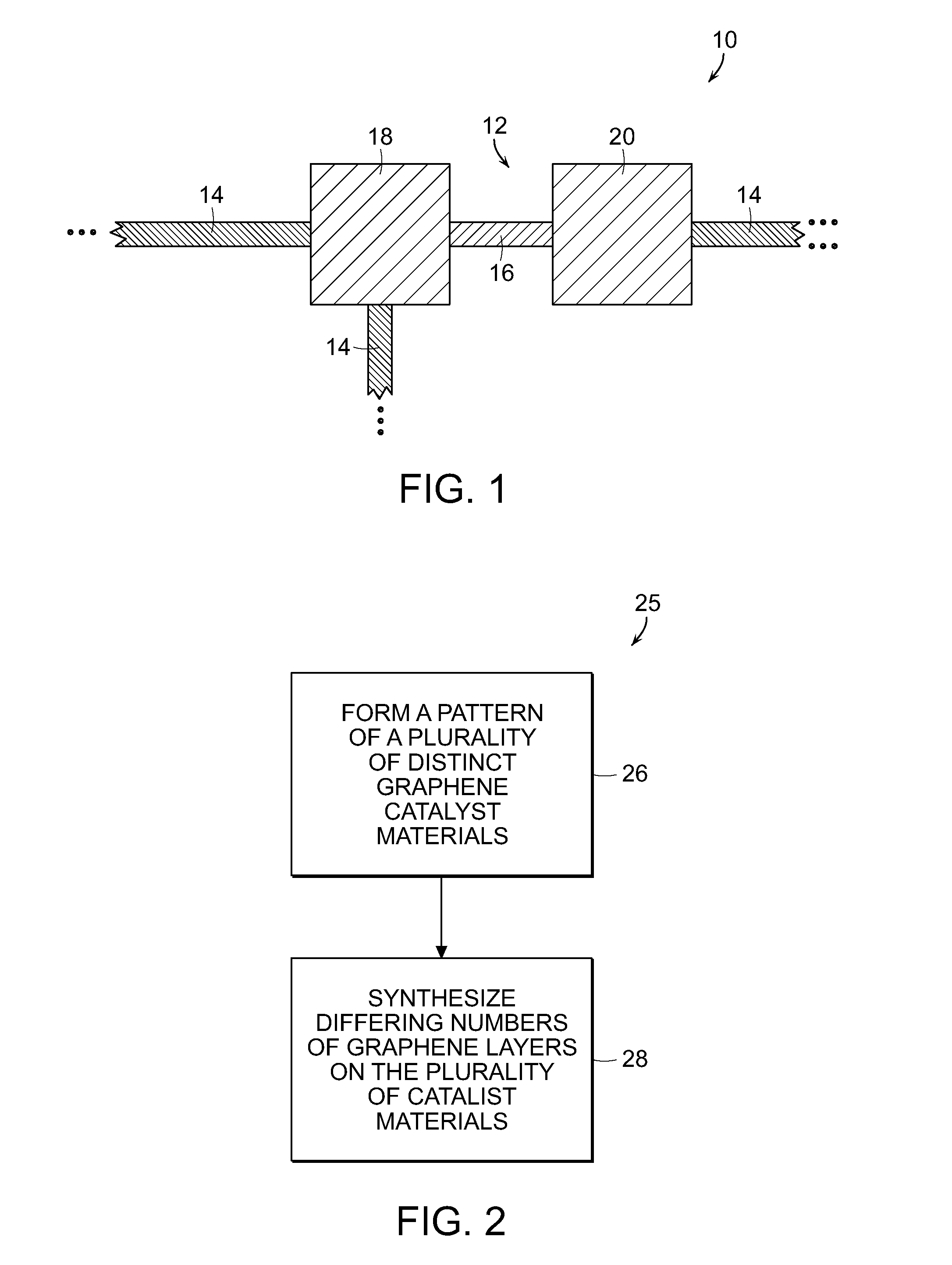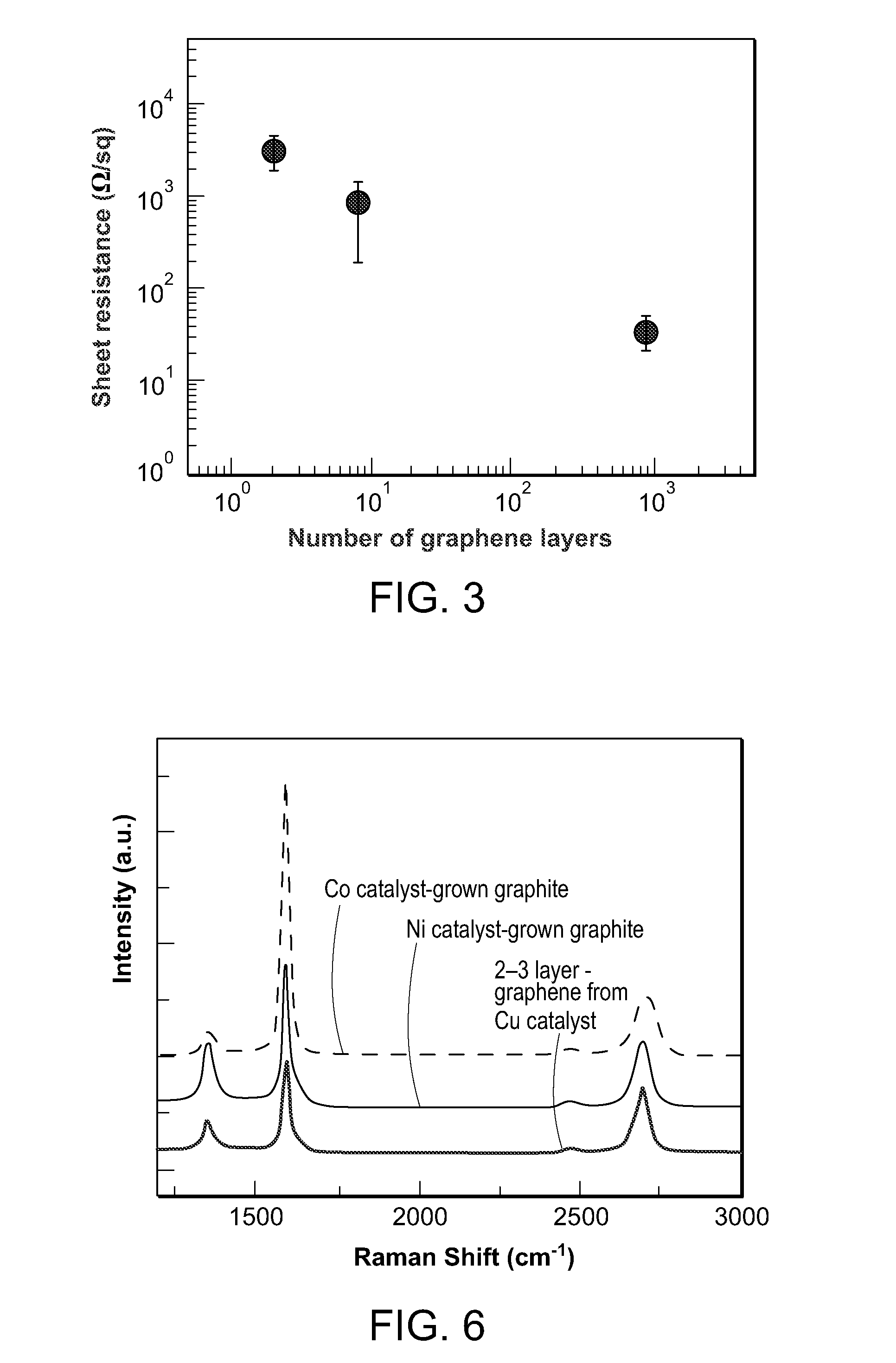Controlled synthesis of monolithically-integrated graphene structure
a graphene structure and monolithic integration technology, applied in the field of graphene, can solve the problems of high complexity of the silicon microfabrication process, process not meeting the specific materials requirements for fabricating a range of device components based on graphene materials, and the inability to achieve the full potential of graphene as a microfabrication material
- Summary
- Abstract
- Description
- Claims
- Application Information
AI Technical Summary
Benefits of technology
Problems solved by technology
Method used
Image
Examples
example i
[0058]A geometry of Cu, Ni, and Co graphene catalyst layers was formed for synthesizing differing numbers of graphene layers simultaneously. A silicon fabrication substrate having a top layer of silicon dioxide of about 250 nm in thickness was coated with a film of Cu of 700 nm in thickness having a 5 nm-thick Ni passivation layer to protect against Cu oxidation. Regions of Co of 10 nm, 60 nm, 80 nm, and 120 nm in thickness were patterned and regions of Ni of 20 nm in thickness were patterned in various shapes, all on the Cu / Ni layers. The catalyst structures were subjected to a graphene synthesis step as described above, with the temperature ramped to 1000° C. while the structure was positioned at the edge of the furnace, under the flow of H2 gas at 1200 sccm and Ar gas at 500 sccm. When the furnace reached the graphene synthesis temperature, the substrate was quickly moved to the center of the heating zone. CVD synthesis of the graphene materials was then be carried out under cond...
example ii
[0064]Following the graphene synthesis process of Example I, a graphene catalyst region of Cu of 700 nm in thickness having a 5 nm-thick Ni top layer and a graphene catalyst region of a layered combination of Cu / Ni / Co of thicknesses 700 nm / 5 nm / 400 nm was subjected to the synthesis process of Example I. With the PMMA handle layer transfer procedure of Example I, the resulting graphene and graphite structures were transferred to a layer of 285 nm-thick silicon dioxide on a silicon wafer, and the structures were plasma etched with an oxygen plasma to produce channel regions. Electrodes were then deposited as 70 nm-thick Au regions, with a 3 nm-thick Cr adhesion layer. FIG. 9A is a schematic of this arrangement, with a channel 70 between a source, S, and drain, D, on the oxide layer 72 and substrate 74. The Cu / Ni catalyst region produced a graphene region of 2-3 layers and the Cu / Ni / Co catalyst region produced a region of about 850 layers of graphene.
[0065]FIG. 9B is a plot of current ...
example iii
[0066]A back-gated graphene FET like that of FIG. 4F was fabricated following the synthesis process of Examples I and II. A catalyst pattern like that of FIG. 4D was employed, with a blanket coating of Cu of 700 nm in thickness / Ni of 5 nm thickness, for producing a 2-3 layer graphene transistor channel, and regions of Cu of 700 nm in thickness / Ni of 5 nm in thickness / Co of 400 nm in thickness, for producing graphite source (S) and drain (D) transistor regions. After CVD synthesis of the graphene and graphite device regions following the process of Example I, the structure was transferred to a 285 nm-thick SiO2 dielectric layer on a Si wafer after a reactive ion etch (RIE) isolation step, to produce backgate monolithic graphene transistors with graphite S / D regions. The FET channel region was etched to provide dimensions of 1 μm in width and 5 μm in length.
[0067]The current, ID, as a function of backgate voltage, VG, with the silicon substrate biased as the backgate, was measured at ...
PUM
 Login to View More
Login to View More Abstract
Description
Claims
Application Information
 Login to View More
Login to View More - R&D
- Intellectual Property
- Life Sciences
- Materials
- Tech Scout
- Unparalleled Data Quality
- Higher Quality Content
- 60% Fewer Hallucinations
Browse by: Latest US Patents, China's latest patents, Technical Efficacy Thesaurus, Application Domain, Technology Topic, Popular Technical Reports.
© 2025 PatSnap. All rights reserved.Legal|Privacy policy|Modern Slavery Act Transparency Statement|Sitemap|About US| Contact US: help@patsnap.com



